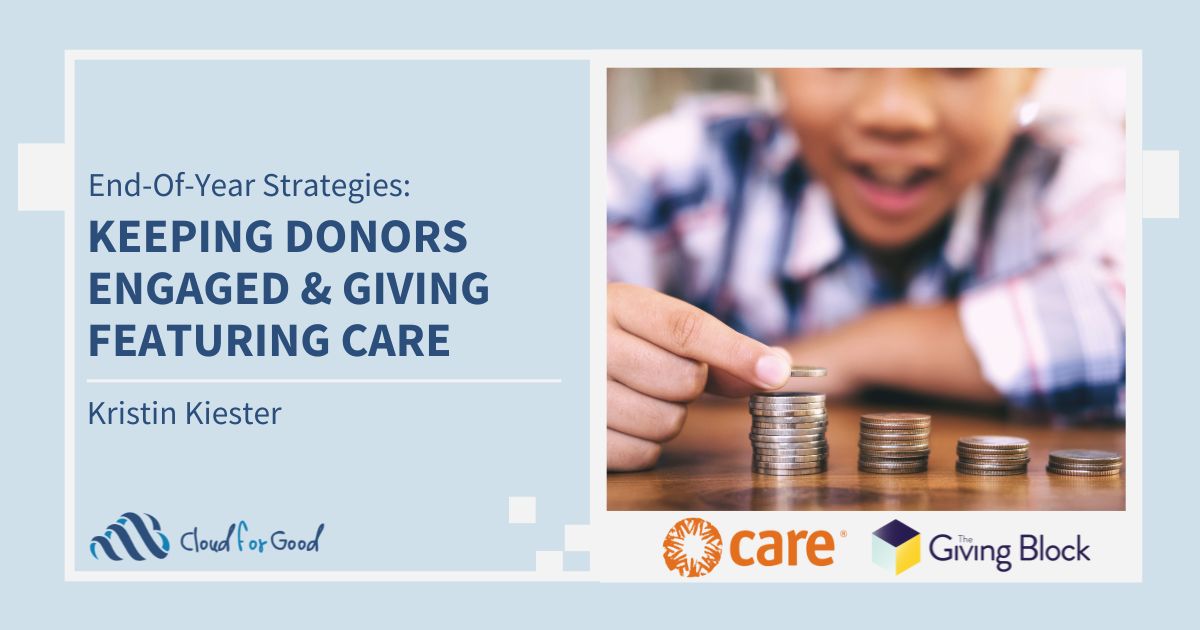31%
of all charitable giving happens in December
12x
more likely to acquire donors on Giving Tuesday
22%
of lapsed donors are more likely to renew support during the end-of-year holidays
5x
more donors engaged through social media campaigns
We all know end-of-year giving reigns supreme, but let’s dive into the key strategies you need to maximize fundraising this time of the year, including diversifying engagement strategies by tapping into new donor demographics, understanding audiences for better engagement, and establishing modern strategies for more effective donor segmentation.
In a recent webinar, I was joined by Carly Evans, Sr. Nonprofit Partnerships Manager at The Giving Block, and Angie Moore, Chief Individual Fundraising Officer at CARE USA, to discuss these strategies designed to keep donors engaged and maximize fundraising outcomes. Below is a review of our covered information and a link to watch the full webinar and learn more.
Diversifying Donors for End-Of-Year
As we head into the end of 2023, according to a Giving USA report, the nonprofit industry has seen a 3% decrease in giving from 2022 (10.5% after accounting for inflation). The total number of donors is also down, though the average gift size is up, and inflation rates are high, putting individual giving at risk.
What can be done in the face of these negative trends? Diversifying engagement strategies by tapping into new donor demographics and offering current donors more modern ways to give is a great way to gain support and combat these trends. With donor pools shrinking, it’s more important now than ever before to consider new donor demographics, such as younger, high-net-worth donor bases with non-cash assets (cryptocurrency, stock, donor-advised funds, etc.) that can be used for giving.
The Giving Block has helped raise over $150M in cryptocurrency, for example, by targeting tech-savvy Gen Z and Millennial givers. This group is financially literate, active on social media, and is an invaluable donor segment to consider as giving becomes more modernized and future-facing. We know the average traditional donor profile is age 65 and made an average online donation of $204 in 2021. In comparison, the average crypto donor profile features people in their 30s with an average income of $111K, and 45% will donate $1K or more.
To help these donors maximize their gifts, consider implementing matching campaigns where major donors pledge matches to incoming donations for a certain amount of time up to a certain amount. Knowing that a donation during this time will result in even more impact for the organization is appealing to potential donors and a great way to maximize end-of-year giving.


CARE USA
Understanding Audiences for Better Engagement
The key takeaway is not that crypto is the be-all and end-all, but that valuable nuance can be understood and leveraged within your donor groups. Take the time to understand what you know about your current donors and what is most important to them. What specific parts of the nonprofit’s mission do they give for? When do they tend to give, and what appeals or tactics (matches, deadlines, etc.) do they respond best to?
There is insight in your data that can be leveraged to maximize the potential of the current giving base and attract and retain new donor demographics ready and willing to support your cause using more modern methods. Once data is collected, it’s critical to have a defined plan for using that data. What data will drive your engagement strategy? Traditional data points gathered in a nonprofit organization’s data strategy can be leveraged to create tailored engagement plans that unlock insights into donor profiles and remove barriers to larger, more consistent donor giving.
Analyzing a donor’s giving history can lead to the formation of donor tiers, which helps to conceptualize the impact of each donation and how that contributes to fundraising goals and better segment donors into clearly defined engagement plans relative to their unique giving history.
Along with this same line of thinking is the use of wealth screening and external data to help drive donor targeting for campaigns based on major and planned gifts. Much like giving history, a donor’s engagement activity with the organization (website interactions, email responses, volunteering, social media activity, etc.) helps define which platform is best used when interacting with the donor to reach them more efficiently and encourage engagement more effectively.
Segmentation Strategies
All in all, nonprofit organizations must understand what people want and provide that to them. Organizations must be agile, ready to pivot, and have the presence of mind to embrace creativity. Don’t waste time on forcing strategies or segmentation methods that have struggled in the past. It is critical to understand what motivates constituents and then feed into that motivation by removing barriers to entry through modernization.


CARE USA
Next is to establish where constituents feel a sense of community and tap into that. Meet your donors where they are and engage with them on the platforms that mean the most to them. With less donor demographic data in the ecosystem, nonprofit organizations must do more with less by establishing a pathway to learn about supporters in non-traditional avenues.
To summarize, nonprofit organizations approaching end-of-year fundraising strategies should look to define and understand audiences, develop strategies to support smarter segmentation, incorporate non-cash assets, embrace emerging communities, and personalize engagement by audience and platform.


CARE USA
With these key takeaways in mind, modern organizations will be better equipped to reach modern donors, combat downward trends in the ecosystem, and ensure prosperity for the missions standing to benefit from these end-of-year strategies.





